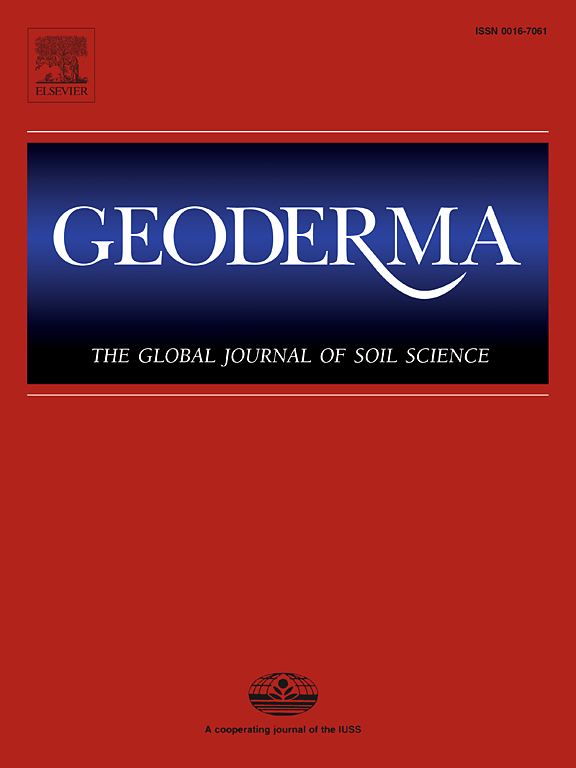Elucidating the role of ferrihydrite and goethite in the aggregation and stability of small soil microaggregates: An experimental study on arable Luvisols under different management
IF 5.6
1区 农林科学
Q1 SOIL SCIENCE
引用次数: 0
Abstract
Iron oxides, exhibiting positive surface charge in most acidic to neutral soils, are key inorganic agents for microaggregate formation, especially via their electrostatic interactions with negatively charged surfaces on organic and inorganic soil compounds. Yet, little is known on the influence of Fe oxide properties, i.e., size, shape, and surface charge on the formation of soil microaggregates (SMA). Here the aggregation of < 20 μm small SMA fractions in the presence of either ferrihydrite or goethite as well as the stability of the resulting aggregates were examined. Water stable small SMA fractions were isolated from Ap-horizons of Stagnic Luvisols under different management (cropped and bare fallow), and both had an average diameter of ∼ 6 μm. Ferrihydrite and goethite, respectively, were added as suspensions to small SMA fractions at 1 or 5 wt%. For comparison, humic acid (HA), a common fraction of soil organic matter, was added at 1 wt% in solution. Laser diffraction was applied to determine changes in the hydrodynamic diameter and the stability of the resulting aggregates. Addition of Fe oxides facilitated the formation of 3 − 10 μm SMA, which probably resulted from their aggregation with < 3 μm particles in the small SMA fractions via electrostatic attraction. Moreover, changes in the particle size distribution also suggested that the addition of Fe oxides decreased the share of > 10 μm SMA, thereby increasing the abundance of 3 − 10 μm small SMA as well. Here it is likely that attachment of Fe oxides on SMA caused a rearrangement of their structure leading to a closer packing of particles. A generally higher decrease in the abundance of > 10 μm SMA in the ferrihydrite addition implied a more efficient compacting effect of ferrihydrite than that of goethite. This was presumably due to the smaller size of ferrihydrite, which can decrease the steric hindrance and provide more contact points. Changes in the size distribution of small SMA fractions were more pronounced after the addition of 5.0 wt% Fe oxides compared to the 1.0 wt% ones. In contrast, adsorption of the added HA on SMA increased their negative surface charges and steric hindrance between them, thereby favoring their dispersion rather than aggregation. In the stability test, both ferrihydrite and goethite showed a less effective stabilizing effect on SMA at the bare fallow site than the cropped one. However, ferrihydrite generally revealed a better ability to stabilize < 1 μm colloids in the small SMA fraction than goethite for both sites. Here, our study provides new insights into the abilities of different Fe oxides to form and stabilize aggregates in soil microaggregation.
阐明水合铁和针铁矿在土壤微团聚体聚集和稳定性中的作用——不同管理下耕地油菜的试验研究
氧化铁在大多数酸性到中性土壤中表现出正电荷,是微团聚体形成的关键无机因子,特别是通过它们与有机和无机土壤化合物上带负电荷的表面的静电相互作用。然而,对于铁氧化物的性质,即大小、形状和表面电荷对土壤微团聚体(SMA)形成的影响知之甚少。这里是<;在水合铁或针铁矿存在的情况下,研究了20 μm的SMA小组分以及所产生的团聚体的稳定性。水稳定的小SMA组分在不同管理下(种植和裸休耕)从Stagnic Luvisols的ap层中分离出来,平均直径均为~ 6 μm。将水合铁和针铁矿分别作为悬浮液添加到小的SMA馏分中,重量为1或5 wt%。为了进行比较,土壤有机质中常见的腐植酸(HA)在溶液中添加1wt %。激光衍射被用于确定流体动力直径的变化和所产生的聚集体的稳定性。Fe氧化物的加入促进了3−10 μm SMA的形成,这可能是它们与<的聚集所致;3 μm颗粒在SMA小组分中通过静电吸引。此外,粒度分布的变化也表明,Fe氧化物的加入降低了>;10 μm SMA,从而也增加了3 ~ 10 μm小SMA的丰度。在这里,很可能是铁氧化物在SMA上的附着引起了它们结构的重排,从而导致了更紧密的颗粒堆积。>丰度普遍较高的下降;在水合铁中添加10 μm SMA,表明水合铁的压实效果优于针铁矿。这可能是由于水合铁的尺寸较小,这可以减少空间位阻并提供更多的接触点。与添加1.0 wt%的铁氧化物相比,添加5.0 wt%的铁氧化物后,SMA小组分的尺寸分布变化更为明显。相反,添加的HA在SMA上的吸附增加了它们的表面负电荷和它们之间的空间位阻,从而有利于它们的分散而不是聚集。在稳定性试验中,水合铁和针铁矿对裸休地SMA的稳定效果都不如刈割后的有效。然而,水合铁通常表现出更好的稳定<的能力;1 μm的胶体在小的SMA分数比针铁矿在两个地点。在这里,我们的研究为不同铁氧化物在土壤微团聚体中形成和稳定团聚体的能力提供了新的见解。
本文章由计算机程序翻译,如有差异,请以英文原文为准。
求助全文
约1分钟内获得全文
求助全文
来源期刊

Geoderma
农林科学-土壤科学
CiteScore
11.80
自引率
6.60%
发文量
597
审稿时长
58 days
期刊介绍:
Geoderma - the global journal of soil science - welcomes authors, readers and soil research from all parts of the world, encourages worldwide soil studies, and embraces all aspects of soil science and its associated pedagogy. The journal particularly welcomes interdisciplinary work focusing on dynamic soil processes and functions across space and time.
 求助内容:
求助内容: 应助结果提醒方式:
应助结果提醒方式:


